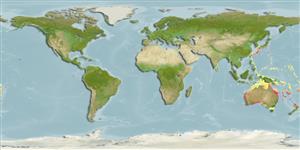Teleostei (teleosts) >
Eupercaria/misc (Various families in series Eupercaria) >
Labridae (Wrasses) > Corinae
Etymology: Pseudojuloides: Greek, pseudes = false + Greek, iouis = a fish without identification, perhaps some of genus Coris cited by Plinius + Greek, oides = similar to (Ref. 45335); elongatus: Named for its elongate body form (Ref. 123183).
Environment: milieu / climate zone / depth range / distribution range
Ecology
Marine; reef-associated; depth range 2 - 50 m (Ref. 86942), usually 2 - 25 m (Ref. 123183). Temperate
Southwest Pacific Ocean: Australia, Lord Howe I., Norfolk I. New Caledonia, NE New Zealand.
Size / Weight / Age
Maturity: Lm ? range ? - ? cm
Max length : 14.0 cm TL male/unsexed; (Ref. 2272)
Dorsal spines (total): 9; Dorsal soft rays (total): 12 - 13; Anal spines: 3; Anal soft rays: 12; Vertebrae: 25. This species is distinguished from its congeners by the following characters: absence of median predorsal scales; corner of mouth with a large canine tooth. Colouration: body of males primarily olive-green, the upper body with 0–4 rows of metallic blue spots, not overlain in black; females are unmarked and olivaceous overall (Ref. 123183).
Usually in kelp and other weedy areas at 2-25 m (Ref. 123183).
Life cycle and mating behavior
Maturities | Reproduction | Spawnings | Egg(s) | Fecundities | Larvae
Oviparous, distinct pairing during breeding (Ref. 205).
Randall, J.E. and H.A. Randall, 1981. A revision of the labrid fish genus Pseudojuloides, with descriptions of five new species. Pac. Sci. 35(1):51-74. (Ref. 2140)
IUCN Red List Status (Ref. 130435)
Threat to humans
Harmless
Human uses
Fisheries: commercial; aquarium: commercial
Tools
Special reports
Download XML
Internet sources
Estimates based on models
Preferred temperature (Ref.
123201): 17.6 - 26.8, mean 23.3 °C (based on 152 cells).
Phylogenetic diversity index (Ref.
82804): PD
50 = 0.5000 [Uniqueness, from 0.5 = low to 2.0 = high].
Bayesian length-weight: a=0.00490 (0.00204 - 0.01176), b=3.11 (2.90 - 3.32), in cm total length, based on LWR estimates for this (Sub)family-body shape (Ref.
93245).
Trophic level (Ref.
69278): 3.4 ±0.4 se; based on size and trophs of closest relatives
Resilience (Ref.
120179): High, minimum population doubling time less than 15 months (Preliminary K or Fecundity.).
Fishing Vulnerability (Ref.
59153): Low vulnerability (10 of 100).
Nutrients (Ref.
124155): Calcium = 36 [14, 67] mg/100g; Iron = 0.238 [0.124, 0.566] mg/100g; Protein = 18.2 [15.3, 20.5] %; Omega3 = 0.278 [0.132, 0.568] g/100g; Selenium = 6.47 [2.46, 16.70] μg/100g; VitaminA = 95.2 [19.8, 546.7] μg/100g; Zinc = 0.85 [0.51, 1.62] mg/100g (wet weight);
